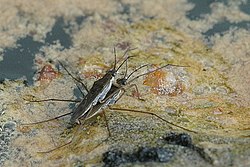Gerris lacustris
| Gerris lacustris | |
|---|---|
 |
|
| A pair of common water striders copulating | |
| Scientific classification | |
| Kingdom: | Animalia |
| Phylum: | Arthropoda |
| Class: | Insecta |
| Order: | Hemiptera |
| Suborder: | Heteroptera |
| Infraorder: | Gerromorpha |
| Family: | Gerridae |
| Genus: | Gerris |
| Species: | G. lacustris |
| Binomial name | |
|
Gerris lacustris (Linnaeus, 1758) |
|
Gerris lacustris, commonly known as the common pond skater or common water strider, is a species of water strider, found across Europe.
Water striders vary in length ranging between 8 millimetres (0.31 in) and 10 mm (0.39 in) in size. Their body shape is very slender and elongated. They have six legs; the first pair is short and stubby while the other two pairs are thin and elongated which are used for moving over the water surface which we call "walking on water". The first pair of legs is used for holding its prey, the middle pair propels the bug along the surface of the water with either a rowing or jumping motion, and the hind pair of legs is used as rudders. The entire body of G. lacustris including its legs is covered with many tiny hairs that have a wax-like coating. G. lacustris are dark brown in colour. Water striders have very strong sucking mouthparts known as a rostrum or beak.
G. lacustris females are usually significantly larger than the males and the egg production rate is limited by the amount of food resources that are available to the female; the more food there is the more eggs the female lays. The adult water striders emerge around April and May. It is around this time that females lay eggs where the eggs undergo a process that takes about 12 to 14 days to develop before they are able to hatch. Hatching doesn't necessarily follow the eggs when their development is complete; hatching heavily depends on the temperature that the egg is exposed to in its environment. After hatching, G. lacustris go through another separate development process known as incomplete metamorphosis. In this process, the larvae or nymphs progress through a series of moults which basically are stages known as instars. There are five instars in the developmental process, with each one progressively longer than the last. The incomplete metamorphosis process usually lasts about 24 to 30 days for larvae to become an adult. G. lacutris males prolong their mating in the presence of other males because they are guarding their female against harassment from the other males. It was found that males influence the duration of copulation while the females influence the copulation frequency.
...
Wikipedia
